Results 1 to 9 of 9
 31Likes
31Likes
Thread: Neil Miller guide to razor hones
Hybrid View
-
01-27-2022, 06:16 PM #1Senior Member




- Join Date
- Dec 2012
- Location
- Egham, a little town just outside London.
- Posts
- 3,746
- Blog Entries
- 2
Thanked: 1077 Neil Miller guide to razor hones
Neil Miller guide to razor hones
I thought I'd share some words of wisdom from the late, great Neil Miller.
For the beginners and newer members that didn't get to learn and interact with Neil he was a fountain of knowledge, just search his name and you'll see what I mean. Neil also produced some of the best strops that you could wish for.
Part 1 of Neil Miller’s series on Hones.
Call them what you will: whetstones, sharpening stones, water stones or whatever – sooner or later your razor will have to come into contact with one or more of these. For our purposes we are only concerned with stones that use water as a lubricant, so oil-stones do not apply. They come in a large assortment of grades (aka grit sizes) from very coarse to ultra-fine. The very coarse grades (eg 325 grit) are for taking off a lot of metal at a very rapid rate. A typical use would be to remove a chip or nick from the razors edge and set a new bevel (the bevel is kind of “v” shaped in cross-section – the bevel planes on each side of the “v” must meet exactly, or no further amount of polishing/honing on successive hones will sharpen the blade).
Once the bevel is set, all we are doing is refining it. A rough rule of thumb is for the next hone to be approximately twice the grit rating of the last stone – the higher the grit size, the finer the hone. The series of stones used from setting the bevel to the final polishing of the blade is known as the “honing progression” – mine, for example, is 325, 600, 1000, 2000, 5000, 10,000 and 16,000. Once we have used a 4000, 5000 or 6000 gritstone, very little metal is removed from the bevels on advancing up the honing progression. If the bevel is not properly set by now, it is time to go back to a coarser stone. Imagine the “v” not coming to a point, but having a small flat area at its peak before the next bevel coincides with it – all the finer stones will do is polish the steep face of each bevel, not remove the flat area at the top of the “v” so the blade will never be truly sharp and be unfit to shave with.
When to stop refining (or polishing) the bevel is a matter for personal choice. 8000 grit seems to be about the practical limit, while 10,000 will often give a superior shave. I stop on a 16,000, sometimes a 20,000 grit hone but many people go higher. The process of refinement need not stop with the honing stones – many people go from the final hone to a pasted paddle or strop and further refine the edge with compounds, powders, and pastes.
You can over-refine the edge though. Excessive laps (on any hone, not just the finisher) will do this, leaving a weak and attenuated cutting edge. The remedy is to de-burr the edge if necessary (ie remove the fin or burr, drawing the edge over a bit of horn will do this) and dropping down to the previous hone.
USES
Damage Removal
To remove larger nicks, dings, fleabites – call them what you will, coarse hones must be used, for example between 325 grit and 1000 grit rating. For tiny areas of damage hones in the region of 1000 – 4000 grit will suffice. The coarser hones are also excellent at removing blade honing defects, like frowns (a narrower width in the middle of the blade) and smiles (a wider width in the middle of the blade). This is done by sawing the blade back-and-forth (called “breadknifing” because the action is like cutting a slice of bread) until the profile is straight. Note that some smiles were intentional, particularly among older open razors. Such razors are often said to be more comfortable and forgiving to shave with, and some old barber manuals go into detail about setting a smile on a straight blade.
Essential Maintenance
Otherwise known as “touching up” – this is required whenever the blade feels a little dull after stropping or as a regular routine for keeping the edge in tip-top condition. All you need is a finishing hone, somewhere in the region of 10,000 grit or higher. Not may strokes are necessary – or desirable – about 5 laps should do it on a small barber-type hone (a lap is counted as a stroke one way plus a stroke the other way). On larger hones perhaps 2 or 3 laps is all that is required.
Preliminaries
Using a Slurry
Some – though by no means all hones – can be made more versatile by the use of a slurry. Such hones are wetted and rubbed with a small piece of stone (it may be the same type of stone as the hone or a softer stone such as a nagura or artificial nagura) until a thin, milky slurry builds up. When used like this, the slurry constantly micro-abrades the surface of the hone so that fresh particles are exposed, making the honing go much faster. The downside is that it also makes the blade edge a little less refined. To get around this, towards the end of honing the slurry is constantly thinned with water until only water remains. This will make the edge more finely polished and more refined. Some hones can even be used dry to get a bit more refinement from them. Don’t expect to jump from say 4000 to 8000 grit on the same stone, though!
Lapping a Hone
Apart from diamond plates, all hones should be “lapped” (flattened) before use. Even those that are said to be ready to use straight from the vendor should be regarded with some suspicion and lapped as a matter of course. A diamond plate (see caveats under the relevant section) is quite handy to use, but not essential. All you need is a flat surface such as a thick sheet of plate glass, granite or marble and a number of grades of wet’n’dry paper and plenty of water. Don’t use normal sandpaper. Pour a small puddle of water onto the glass and lay the wet’n’dry on it, face up – the water will set up a suction and hold the paper in place. Soak the hone (if it is capable of being soaked) and draw a grid of lines with a pencil all over the surface to be lapped. Pour a puddle of water on the paper and lay the gridded face of the hone on it, then move it backward and forwards as if sanding the surface. Every now and then remove the stone and look at the gridlines – areas, where they have vanished, indicate high areas on the hone, where the lines remain represent low areas on the hone. Keep flushing the paper with water and moving the hone over it until all the gridlines have vanished. To make doubly sure the hone is flat, draw another grid on it and repeat. This routine is repeated on each ascending grit of wet’n’dry – you might want to start with a P100 grit and work up to P600 by way of P240 and P400, for example.
TYPES OF HONE
There a number of different types of hone, man-made, ceramic, diamond plate and natural stone are, broadly speaking, the main types – although of course there are others. What to buy depends on personal choice, price, speed of operation and how much use you intend to give the hone, eg whether you hone for other people or just for yourself. Any recommendations I give are, of course, restricted to the hones I have used, are only my own personal opinions and other people may have conflicting views.
Man-Made/Synthetic/Artificial Hones
These can be had in all grit ratings, generally need soaking in water before use and are quite fast to very fast in operation. They can be one grit all the way though, or “combination” hones – two grits, one on either side. Makers include King, Ice Bear, Norton, Naniwa, etc. In my opinion, the very coarse hones are not worth the bother – they need “lapping” or flattening (see later) very frequently – too frequently for my liking. The ones I have used for chip removal have required lapping during honing, otherwise, the surface rapidly becoming concave had a deleterious effect on blade profile. They also drink water like it is going out of fashion – a 220 grit stone I used (Sun Tiger) was dry after 5 laps of the razor, even after having been soaked for 30 minutes. A bit much when a 100 laps or so are necessary to remove a small chip.
King
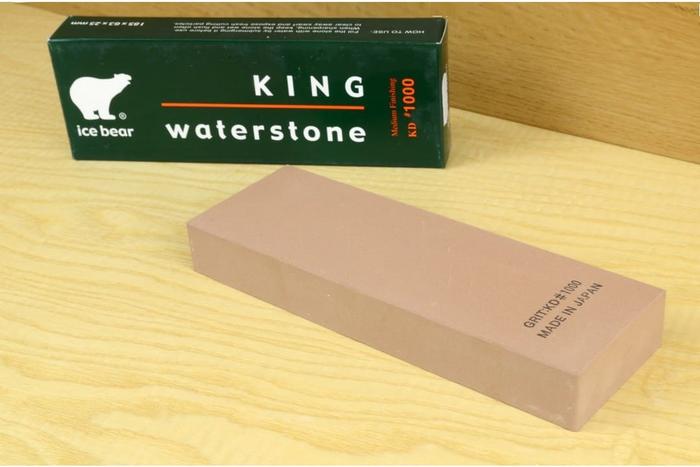
In this series (in my opinion), anything over 1000 is fine – they don’t require lapping too often and they don’t require as much water – an initial soak followed by spraying at intervals suffices. I have used a number of 1000 grit king stones and found them to be fast, relatively cheap and easy to obtain. They are a bit ‘soft’ in composition though and need lapping more than most other 1k hones I have come across. It is also available as a combination 1000/6000 stone which is very useful. The 6000 side is also a great performer. I personally rate these stones as better than the Norton 4000/8000 combination stones which are hard to come by at reasonable prices in the UK. These are used with a slurry, produced by rubbing a small slurry stone over the wet surface of the hone. If anything, they are faster than the quoted grit value, for instance, the 6k side is more like 5k.
Naniwa Chosera
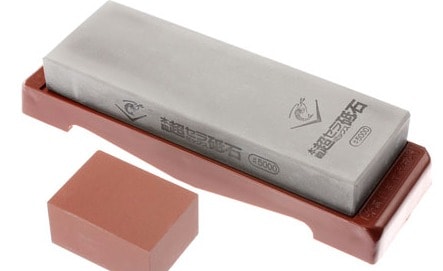
At the time of writing, these are among my favourite hones. The 1k hone is outstanding – a perfect bevel setter. This is followed by a 3k, 5k, and 10k hone. The 10k although high grit rating is not what I would call a finishing hone – rather it is a pre-finisher. There are also problems with the 10k – I have had two now, the first being sent back after six months because the surface became finely crazed. The replacement lasted over a year before this crazing appeared again and on inspection, the 5k showed some small signs of beginning to show hair-line crazing. It lapped out of the 5k but seems pretty deep in the 10k. Lapping it before use ensures that there is no problem, but I would prefer it if it was not displaying this tendency. Like other man-made hones of this type, there is a little differential movement in the hone, most noted at the fine grit end of the range. They come with a huge ‘rubbing’ or cleaning stone and are available with or without a plastic base.
Naniwa Super Hone
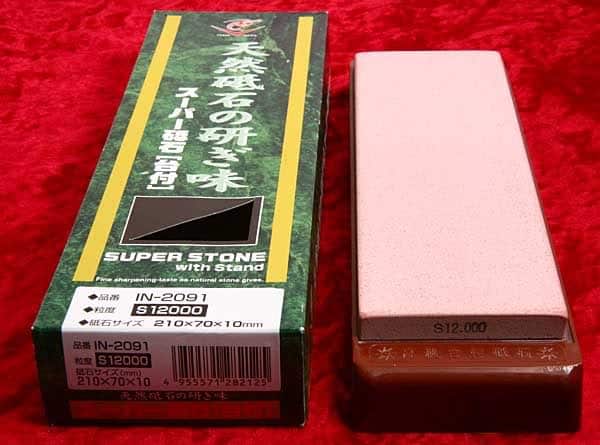
The Naniwa Super Hone series has very good feedback and is cheaper than the Nainwa Chosera series. I have used the whole range, from 1000 to 12,000 grit. All are very good – the 1000 is very fast (they are all quite fast in use) and both the 10,000 and 12,000 are ideal for final finishing hones. Each hone hardly needs more than a small spray of water and although soft they do not require lapping that often. They are very easy to lap, too, being soft – the only problem is “stiction” – a diamond plate is apt to stick quite doggedly to the hone unless the operation is carried out underwater, under running water or a special perforated or grid-marked lapping plate is used. This holds true for a lot of other stones, too. The range is prone to dimensional changes, however, and should not be left in direct sunlight or next to open fires or radiators. No slurry or rubbing stone is required. They come with or without a plastic base and some combos are to be had.
Ceramic Hones
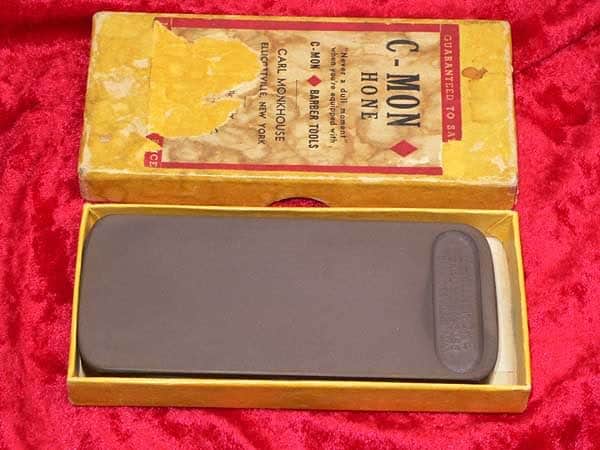
Examples of these would be the small, old-style “barber” or razor hone, Spyderco and Shapton hones and some ranges of modern hones. The barber-style hones are great for travelling with as they are so small – most aren’t more than six inches long – but this makes them a bit restrictive (at least for me) to use all the time. They are generally of a high-grit rating – say about 10,000 and above, unless you manage to find one of the rarer combination types with a coarse and a fine side. The vintage Swaty hones usually receive good reviews, particularly the type called “three-line” (so known because it has three lines of writing on them). They are old now, and every one I have had has needed lapping. They are very hard usually, making lapping a bit of a chore, but not only does it level the surface it also helps to refine the grit to some extent, making some of them finer in operation.
Suehiro Gokumyo
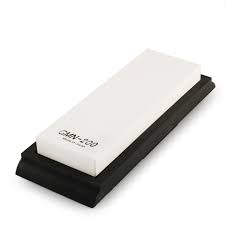
I have the 20k version of this hone and can say it is an excellent hone, on a par with the Shapton 30k Glass Hone. It is fairly hard for the type but gives a truly keen yet smooth edge. It is also quite thick compared to Shapton Glass Stones for example, but even costlier and harder to obtain in the UK. It is one of my favourite finishing hones.
Sigma Power Ceramic Stone
These come in a range but I have only used the 13k one. It is a nice stone, with a ‘soft’ feel although ceramic, and a very good finisher. However, it is often hard to get and sometimes hard to fit into an existing honing progression, depending on the types of hone you already have.
Spyderco
These are very hard and unforgiving, and they come in medium, fine and extra-fine grades and tend to be on the small side compared to other hones, but they are longer than old-style barber hones. The one of choice is the ultra-fine variety, indeed it was originally formulated as a modern barbers hone! I have used them more as bases to hold various fine compounds, and they excel at this.
Shapton Glass Stone
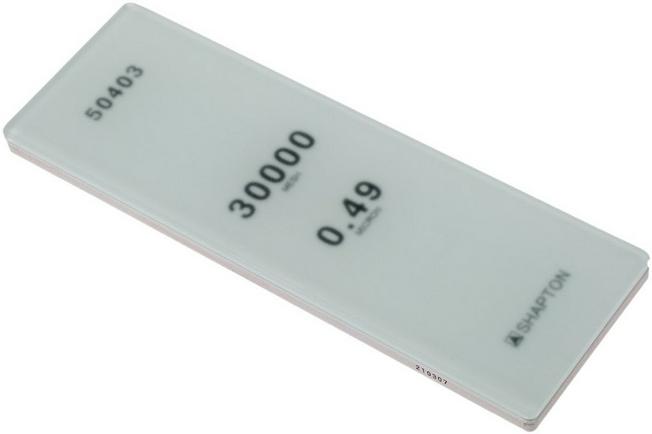
I have used four Shapton Glass Stones (so-called because the backing is a flat plate of glass) – 2000, 8000, 16,000 and a 30,000 grit. All are soft compared to most natural hone stones but do not require over-frequent lapping and they are very fast in use. However, “soft” needs some qualification: by soft I mean they do not feel like a glassy, hard stone in use, although in actuality they are quite hard – especially the 16,000 and 30,000 glass hones. This does not mean that they are a chore to lap – the hardness is nothing like that of a natural stone! The lower grits in this range are quite affordable, but the price rises quite steadily and by the time you get to the 30,000 hone you really have to justify the price. The 30,000 is about the same grit rating as chrome oxide powder, but to my mind better in use. However, I find that not all steels take to it – it over-refines some steels (particularly older Sheffield steels) and is detrimental to the edge. On modern hard steels, it is fine. Some people recommend sticking with an all-Shapton line-up, saying that Shaptons don’t get on with other hones. Mine has never expressed an opinion, though! No slurry or rubbing stone required.
Shapton Pro series.
Shapton has another series of razor hones – Shapton Pro, much thicker and with no glass backing. They are considerably more expensive, though. I have the 15k hone. It is a very capable finisher, leaving a smoother edge than the 16k glass hone. Compared to other hones of the type, it is relatively soft and leaves a good edge on older steels like you find in early Sheffield steel razors.
Stay tuned for part 2Last edited by markbignosekelly; 01-30-2022 at 07:21 AM. Reason: Photos
-
The Following 14 Users Say Thank You to markbignosekelly For This Useful Post:
32t (01-27-2022), 5G62 (02-01-2022), bluesman7 (01-28-2022), BobH (01-27-2022), dimab (01-28-2022), DZEC (01-27-2022), JOB15 (01-30-2022), PaulFLUS (10-19-2023), petercp4e (01-27-2022), randydance062449 (01-28-2022), RezDog (01-27-2022), sharptonn (01-28-2022), Steve56 (06-05-2022), STF (01-27-2022)
-
01-28-2022, 01:41 AM #2Hones & Honing



- Join Date
- May 2005
- Location
- Saint Paul, Minnesota, United States
- Posts
- 7,974
- Blog Entries
- 1
Thanked: 2204
This is a very useful Thread. I hope it becomes a sticky and is included in the Library.
Thanks a bunch for putting this together. Randolph Tuttle, a SRP Mentor for residents of Minnesota & western Wisconsin
Randolph Tuttle, a SRP Mentor for residents of Minnesota & western Wisconsin
-
01-28-2022, 03:43 PM #3Senior Member




- Join Date
- Dec 2012
- Location
- Egham, a little town just outside London.
- Posts
- 3,746
- Blog Entries
- 2
Thanked: 1077
Thanks Randy, this would be great as a sticky. I don't think there are many members that haven't learnt from Neil's knowledge and experience.
-
01-28-2022, 03:53 PM #4

I agree.
This needs a place of prominence and should be very easily accessible to all.
Pete <:-}"Life is short, Break the Rules. Forgive quickly, Kiss Slowly,
Love truly, Laugh uncontrollably, And never regret ANYTHING
That makes you smile." - Mark Twain
-
01-28-2022, 04:05 PM #5

Come to think of jt Mark, why not give it a spot on the front page under the SOTD and SOTM.
Pete <:-}"Life is short, Break the Rules. Forgive quickly, Kiss Slowly,
Love truly, Laugh uncontrollably, And never regret ANYTHING
That makes you smile." - Mark Twain
-
01-28-2022, 05:00 PM #6Senior Member




- Join Date
- Dec 2012
- Location
- Egham, a little town just outside London.
- Posts
- 3,746
- Blog Entries
- 2
Thanked: 1077
-
The Following User Says Thank You to markbignosekelly For This Useful Post:
petercp4e (01-28-2022)
-
01-28-2022, 05:02 PM #7Hones & Honing



- Join Date
- May 2005
- Location
- Saint Paul, Minnesota, United States
- Posts
- 7,974
- Blog Entries
- 1
Thanked: 2204
-
The Following User Says Thank You to randydance062449 For This Useful Post:
petercp4e (01-28-2022)
-
01-28-2022, 04:57 PM #8Senior Member




- Join Date
- Dec 2012
- Location
- Egham, a little town just outside London.
- Posts
- 3,746
- Blog Entries
- 2
Thanked: 1077
Part 2 of Neil Miller’s guide to hones
Natural Hones/Waterstones
There are a large number of these available, some of questionable value to the open razor owner, some capable of superb results and others remarkably hyped-up – particularly on razor forums – beyond all reasonable measure. My advice to somebody beginning to hone is to avoid these at first and get a set of man-made hones. That way you will understand the grit rating of each hone and be able to place it in a honing progression. Natural hones, of course, cannot be assigned a grit rating. We attach an estimate of grit value to them as a means of describing them, but this can vary, sometimes quite wildly, even for natural hones of the same type. The British Isles sport a fair number of natural sharpening stones suitable for our uses. They range from low grit to finishing hones. A partial, though by no means comprehensive list follows.
Dalmore Blue
From Scotland again, approx 4000 grit, perhaps peaking at 5000. Medium to slow speed, useful for refining a bevel but not really fast enough for setting one. Originally hones were taken from Craiksdale Quarry but were later transported to the Water of Ayr & Tam O’Shanter Honeworks at Stair for sale. The Dalmore Blue was sold as a ‘medium’ grit hone, followed in terms of increasing fineness by the Tam O’Shanter (ordinary and fine) and the Water of Ayr (very fine). They are mostly not blue in colour, having a greyish/greenish sort of colour, perhaps with a hint of blue. Most noted for the lovely swirls of colour in them, most are quite highly patterned.
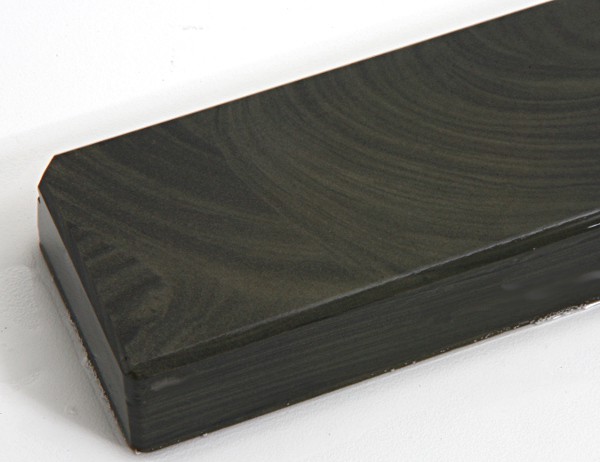
Tam O’Shanter
Another from Scotland, approx 8000 grit (I have had white ones that were higher), although some people rate them as low as 6000 grit – again, they are natural stones so there is no conformity to them. Lovely speckled pattern. Reasonably fast in use and considered by some as a finishing stone and for removing micro-nicks. If going on to a finer hone it is said to impart a smooth quality to the edge. It has another attractive quality too – it is one of the few hones that can be used effectively on razors that are prone to micro-chipping during honing. If used with a slurry (made by rubbing a slurry-stone over the surface) it cuts a lot faster.
An interesting point is that the Tam O’Shanter was sold in two varieties: one for cabinet makers, etc, and a “fine” version for razors. The distinction is made on the label and on the original box, so it is not seen that often. The one fine version that I have been able to verify had a grit equivalence higher than my 8,000 grit stone. There is another variant that does not look like the other TOS stones – the white Tam O’Shanter. This one was sold for producing “very fine edges” and is finer again than the fine Tam O’Shanter mentioned above.
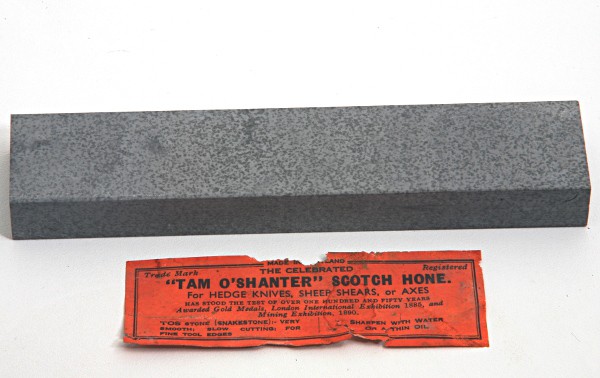
Water of Ayr
Another offering from Scotland. The Tam O’Shanter was originally listed as “fine” and the Water of Ayr as “very fine.” Historically, the Tam O’Shanter and Water of Ayr stones, although quite different, were lumped together and known as “Scottish hone” or “snake stone” so today there is still a little confusion so make sure of what you are buying – only the Tam is very speckled. The Water of Ayr gives a very fine edge and is in the region of 9,000 – 11,000 grit size. It is identified by the presence of sporadic dark dots, sometimes quite large, sometimes joined together with faint lines
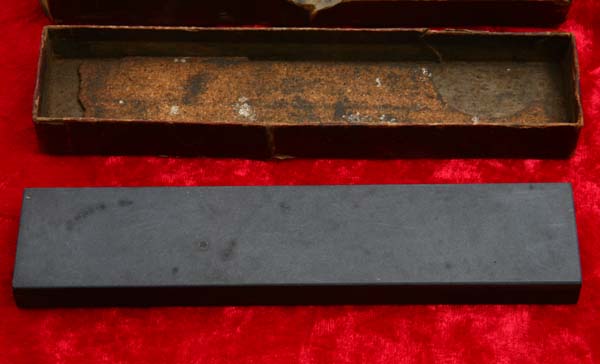
Belgian Blue Stone (BBW)
This stone occurs in the Ardennes and is a garnet-rich hone of around 4000 grit equivalent. Most of these hones give excellent polishing results, removing the lines left by coarser hones, but they are generally regarded as slow – too slow for bevel formation. The usual caveat applies – it is a natural stone, and different samples may display different characteristics. For instance, I have a BBW hand-selected by the mine owner – it is midway between a BBW and a yellow coticule in garnet size and cutting speed, and I would rate it somewhere above 5000 grit. Historically, the BBW was thought of as insignificant from a honing point of view and was used as a backing for the yellow coticule because it was regarded as cheap and disposable (natural slate is used now). The BBW works with a slurry. It does not need to be soaked before use.
Belgian Yellow Coticule
These are remarkably versatile garnet-rich stones, found in the same place as the BBW. When soft, they can be used to cut metal quite fast with a creamy slurry, and do the work of 6000 – 8000 grit hones. Reducing the consistency of the slurry slows the cutting rate down, but makes the stone cut like a finer grit. Using just water provides the keenest edge (some say using it dry gives the keenest edge). Harder yellow coticules are not so good as cutters and are mainly intended to be final polishing hones. A conservative estimate of grit size would be around 10,000. The yellow coticule has long been prized as a honing stone – the Romans made much of them when they conquered the area. Devotees say they give a much smoother shave than other hones, due to the shape of the micro-garnets which smooth the edge. The older stones are said to be the best – certainly, one vintage coticule I owned was a superb finisher. Sometimes they are available as a combination stone, being bonded to a piece of BBW instead of slate (see above: this was a matter of convenience in the past, but a selling point now). The stone does not have to be soaked before use. Generally, the softer the hone the more ‘cutting’ speed/power but the edge is markedly softer, the harder the stone the less cutting action, but the edge is finer. If you get one that is a compromise, then that is just what you get – a so-so cutter and a so-so finisher.
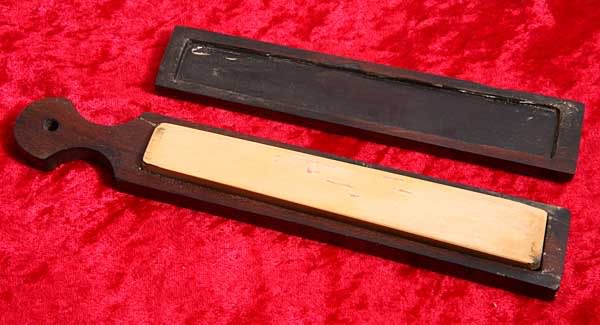
Hybrid or Les Latneuses Coticule.
This is an odd beast. It is not a combination coticule in the strict sense of the word as it is from a layer among other cuticle layers. One side looks fairly conventional, the other has a strange marbled, glassy look to it. The conventional side gives a very good edge – it is hard but quite fast. The other side is extremely hard and difficult to lap, but it gives a very fine edge indeed. When I got one of these I sold all my other cuticles as I was not satisfied with the mushy (aka soft) edge they gave – this type gives an edge unlike most other cuticles and is a delight to use.
One word of warning, though. These coticules are very expensive indeed in larger sizes, mainly due to their fragile nature. The layers separate very easily, and they are prone to fall to pieces if dropped. They do glue back together rather well, though!
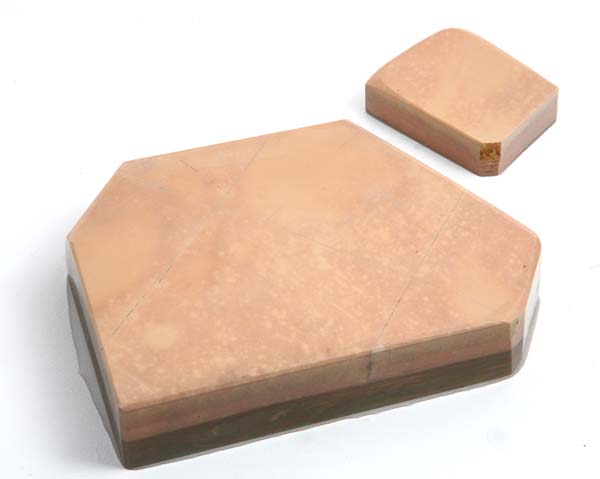
Stay tuned for part 3 gents
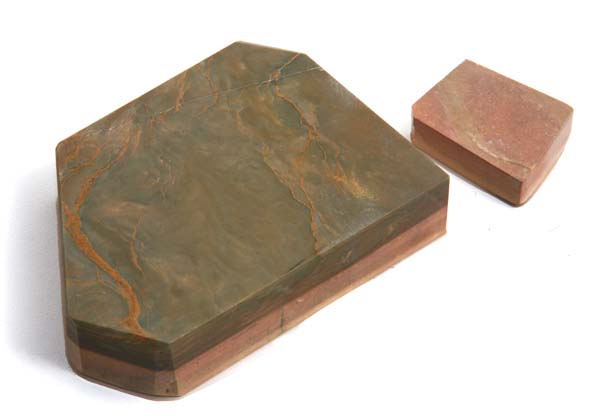
-



 LinkBack URL
LinkBack URL About LinkBacks
About LinkBacks






 Reply With Quote
Reply With Quote
